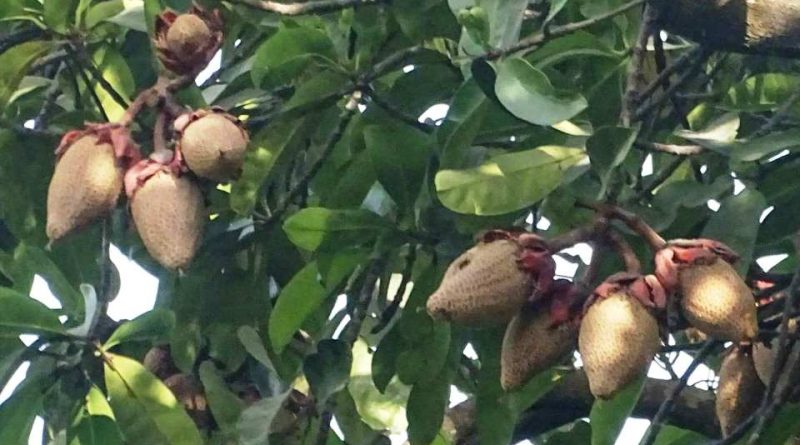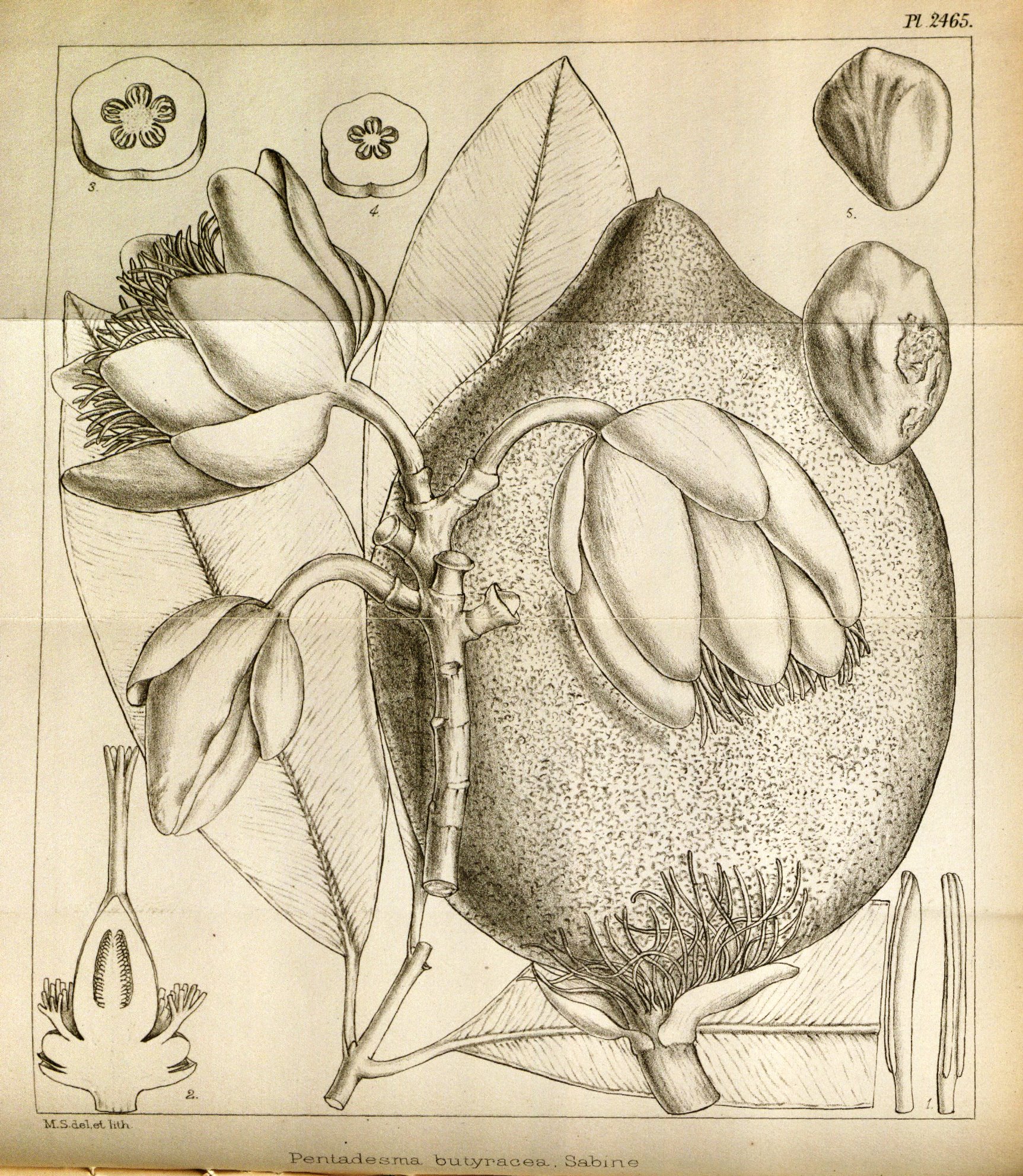Pentadesma butyracea
Pentadesma butyracea
The butter tree or black mango tree, candle tree, candle butter tree, kanya, tallow tree (Pentadesma butyracea Sabine, 1824) is an arboreal species belonging to the Clusiaceae family.
Systematic –
From a systematic point of view it belongs to:
Eukaryota domain,
Kingdom Plantae,
Division Magnoliophyta,
Class Magnoliopsida,
Order Theales,
Clusiaceae family,
Genus Pentadesma,
Species: P. butyracea.
The terms are synonymous:
– Pentadesma kerstingii Engl. ex Volkens;
– Pentadesma lecomteana Pierre;
– Pentadesma lecomteana Pierre ex A.Chev.;
– Pentadesma leptonema Pierre;
– Pentadesma leptonema var. klainei Pierre;
– Pentadesma leptonema var. klainei Pierre ex A.Chev.;
– Pentadesma leucantha A.Chev.;
– Pentadesma nigritana Baker fil.;
– Pentadesma ogoouensis Baudon;
– Pentadesma parviflora Exell.
Etymology –
The term Pentadesma comes from the Greek πέντε pénte, five and δέσμη désme, bundle, bunch.
The specific epithet butyracea comes from the Latin butýrum (in turn from the Greek βούτuρον, butyron from βους bus cow and τυρός tyrόs cheese) butter and from the suffix -aceus, a, in relation to, which resembles, which produces, with reference to presence of oil in the seeds.
Geographic Distribution and Habitat –
Pentadesma butyracea is a plant native to the forests of central-western tropical Africa and present in an area that includes: Benin, Cameroon, Congo, Ivory Coast, Gabon, Ghana, Guinea, Guinea-Bissau, Liberia, Nigeria, Democratic Republic of Congo, Sierra Leone and Togo.
Its habitat is that of the rainforest on humid or marshy ground, mainly on the banks of rivers; at altitudes up to 800 meters.
Description –
Pentadesma butyracea is an evergreen or semi-deciduous tree.
The trunk is straight, cylindrical, which grows to a height of about 20 – 30 meters; the bark is brownish in color and finely fissured longitudinally.
The leaves are borne by a petiole about 2.5 cm long; they are opposite and grouped at the apex of the branches; they have a generally obovate shape and are 10-20 cm long and 3-7 cm wide, with a leathery consistency, a shiny intense green color above, light green below and dotted with resinous glands.
The flowers are grouped in panicle inflorescences, each of which bears 1-7 flowers with ovate petals 6 cm long, reddish white to greenish white in colour, and numerous stamens gathered in five bundles fused at the base.
The flowers give off a smell reminiscent of rancid butter. Furthermore, they are pollinated by the Woermann’s bat (Megaloglossus woermanni Pagenstecher, 1885) and other mammals.
The fruits are ellipsoid-shaped berries and reddish brown in color with a pointed apex; they have dimensions of 10-15 cm in length and 6-10 cm in diameter; the pulp is yellow, edible and sweet in ripe fruits, bitter in unripe ones.
Inside the fruits we find, immersed in the pulp, from 3 to 15 flattened seeds, 3-4 cm long, brown in colour.
Cultivation –
Pentadesma butyracea is a multipurpose plant, commonly used locally as a source of food, medicines and other products, but little cultivated outside its areas of origin.
This plant, which grows in tropical lowland areas (up to a maximum of 800 m above sea level), does not grow in areas where the average annual rainfall is less than 1,000 mm.
It prefers deep soil and is often found in the wild in leached soils.
In plantations, trees grow to a height of 9 meters in 10 years.
The trees flower for the first time when they reach about 8 meters in height. Flowering occurs throughout much of the year, but especially during the main rainy season.
The flowers produce large quantities of nectar, which is eaten by monkeys; these, in addition to the bat, are probably important pollinators.
This tree reproduces easily by seed which must be planted as quickly as possible because it quickly loses germination; the substrate must be draining, rich in humus, and at a temperature of 22-26 °C. Germination occurs in about 2 weeks, and sometimes begins in the fruit itself.
Fresh seeds germinate well in shade under room conditions. Germination begins after approximately 15 days and reaches 98% two months after sowing. Germinated seeds grow in nurseries, reaching 10 – 28 cm in height after 4 months.
Fresh seeds stored in moist jute bags retain 100% viability after 1 month. However, when using polythene bags, only 15% germinates. Drying does not improve germination; dried seeds stored for two months under ambient conditions germinated at 14% within three months.
Customs and Traditions –
Pentadesma butyracea is a plant known by various common names, among these we remember: black mango tree, butter tree, candle tree, candle butter tree, kanya, tallow tree (English); arbre à beurre, arbre à chandelle, lami (French); mamão, mata step, pau ová (Portuguese); árbol del sebo (Spanish).
This plant has multiple uses, the main one being the production of a type of butter called “kpangnan butter” similar to shea butter. The timber is used in cabinet making and construction.
They are the seeds that are used to make kpangnan butter also called paintya, kanya in Benin, Kanga in Sierra Leone, Akpoto in Togo among others. This butter can be stored for one to three years without going rancid.
Kpangnan is marketed locally, particularly in central Togo and Benin. It is occasionally sold in the United States and Europe as “yellow shea butter”. In reality, shea butter and kpangnan are extracted from two different species of trees and have noticeably different scents, appearances and textures.
The unique feature of kpangnan butter is its high stigmasterol content (about 45% of the sterol content). Stigmasterol is the sterol unsaturated vegetable fat usually found in plant parts such as calabro beans, soybean oil, canola oil and cocoa butter. Stigmasterol is used as a base material in the production of synthetic progesterone, but it has other interesting properties. Research shows that stigmasterol may reduce the risk of some cancers, including ovarian cancer.
The seeds contain 30 to 40% oil consisting of 54% oleic acid, 45% stearic acid, 1.2% palmitic acid and various amino acids; the oil can be extracted by pressing or cooking, it is solid at room temperature, almost tasteless, yellow in color and does not go rancid, it is used for cooking and in the manufacture of margarine, soaps, candles, in the cosmetics industry, etc.
Like shea butter, kpangnan has been harvested in West Africa for generations. It is used in cosmetics (for hair, to moisturize the skin), as an edible oil and for the production of traditional soaps.
Decoctions of roots and bark are also used in traditional medicine.
Traces of flavonins, saponins, tannins, steroids and terpenes were found in the bark and roots of the Congo material.
Furthermore, a fat is obtained from the seed which is used to make soaps, candles, etc.
An ointment for the skin and hair is obtained from the seed oil; it is also applied to kill lice, etc.
The bark contains a yellow, resinous latex, more abundant towards the inside which takes on a red-orange color as it dries.
The roots are used as chewing sticks.
The young stems are used as chewing sticks.
The heartwood is yellowish, reddish or pinkish brown in color; it is clearly delimited by the fairly wide band of sapwood of a color varying from whitish to pale pink. The fiber is straight to slightly wavy; coarse consistency. The wood is heavy, hard, resistant, but not durable, being susceptible to attacks by phytophagous insects, although it is quite resistant to termites. It dries slowly in the air with few cracks.
Wood is easy to work with; saws satisfactorily, but may cause blades to gum up and overheat; planes, polishes, shapes well and drills satisfactorily, although heating may occur; holds well but splits during nailing are quite common; at the end of the process it has an attractive appearance.
However, timber appears to be of limited economic importance. It is sawn into boards and used in rough construction work and for building canoes. It is also suitable for heavy construction, heavy flooring, railway sleepers, ship and boat building, vehicle bodies, boxes and cages, veneer and plywood, interior finishing, furniture and cabinet making, joinery and turning, sporting goods, tools and toys.
Wood is generally used as fuel.
Among other uses, it is reported that the tree is considered suitable for reforestation purposes; it is planted in soil conservation programs.
Preparation Method –
Pentadesma butyracea is a plant that is used in the food, medicinal and other fields.
Among the edible uses, it should be remembered that an edible fat is obtained from the seeds.
Air-dried seeds contain 32-42% solid fat that can be extracted by beating and cooking. It varies in color from light brown to dark brown, is almost tasteless and has a pleasant smell. It is edible and resembles shea butter (Vitellaria paradoxa) to some extent, and has the advantage of not having any bitter latex and not going rancid.
This oil is used for cooking and for making margarine. The fat contains 53.6% oleic acid, 45.2% stearic acid, 1.2% palmitic acid, with an assortment of amino acids.
The seeds are said to be edible before they are fully ripe, but once ripe they become very bitter or sour.
When fully ripe they are sometimes used as an adulterant for kola nuts (Cola spp.).
Kola nuts contain caffeine and are chewed or made into drinks for use as stimulants.
The sweet, yellow pulp of ripe fruits is edible, but unripe fruits are bitter.
The fruit is said to be edible when immature, but becomes too hard when fully ripe.
When you cut the fruit it exudes an abundant yellow and thick juice, similar to the exudate of the bark.
The cooked leaves are eaten as a vegetable. The leaves are mainly used by breastfeeding mothers because they are said to increase milk production.
In the medicinal field, local populations claim that the bark is aphrodisiac, purgative and vermifuge.
A decoction is also used for this purgative effect.
The bark is used to treat diarrhea and dysentery.
An infusion of the bark is used as a cleanser to treat fever.
A macerate of the bark is used as a treatment against skin parasites.
Latex from the bark is applied to the skin as a treatment against skin parasites.
A decoction of the root is used as a vermifuge.
An infusion of the powdered roots is used to bathe babies during weaning.
The fat obtained from the seeds forms a suitable base for topical medicines. Its application relieves chest pain, cough in children, stress and abscesses.
As mentioned, the leaves are eaten by breastfeeding mothers as a vegetable which is said to increase milk flow, make milk more easily digestible and also aid in teething.
The leaves, after being toasted and chopped, are given to children to relieve constipation.
Finally the bark is used as a poison for fish.
Guido Bissanti
Sources
– Acta Plantarum – Flora of the Italian Regions.
– Wikipedia, the free encyclopedia.
– GBIF, the Global Biodiversity Information Facility.
– Useful Tropical Plants Database.
– Conti F., Abbate G., Alessandrini A., Blasi C. (ed.), 2005. An annotated checklist of the Italian vascular flora, Palombi Editore.
– Pignatti S., 1982. Flora d’Italia, Edagricole, Bologna.
– Treben M., 2000. Health from the Lord’s Pharmacy, Advice and experiences with medicinal herbs, Ennsthaler Editore.
Photo source:
– https://inaturalist-open-data.s3.amazonaws.com/photos/61965596/original.jpg
– https://tropical.theferns.info/plantimages/3/8/38dae3c5fcebe4106f5bc23f7eac7a07c28e43dd.jpg
Attention: Pharmaceutical applications and food uses are indicated for informational purposes only, they do not represent in any way a medical prescription; we therefore decline any responsibility for their use for healing, aesthetic or food purposes.


